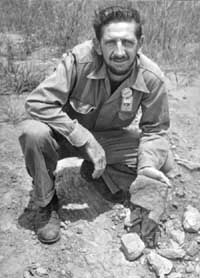By Mary T. Cagle
Editors note: Mrs. Mary T. Cagle served as the first historian for Redstone Arsenal. She retired in 1985 and died in 1997. This article was written in 1955.
Since the inception of Redstone Arsenal, it has been a matter of recorded history that the name Redstone came from "the preponderance of red soil." This simply stated origin of Redstone's name remained undisputed and unquestioned throughout the first fourteen years of its existence.
In May 1955, the Public Information Office started a study in an effort to learn more about the background history of Redstone's name. As a result of this study, several stories were published in THE REDSTONE ROCKET which painted a very colorful and interesting picture of the subject; however, some of the information contained therein was later refuted by several different authoritative sources.
One issue of THE REDSTONE ROCKET, published on June 21, 1955, featured a headline article entitled "ARSENAL GIVEN NAME BY MAJOR H. SACHS." This article contained a quoted letter from Major Sachs, which read in part as follows:
The naming of your installation presented a specially difficult problem and I finally decided to consult then Captain (now Lt. Col.) Jack (J. A.) Goodwin who comes from Anniston, Alabama. He stated that he knew the area well, that it was beautiful country with red rocks predominating. I also believe he stated that it is called the "Redstone" area. Accordingly I submitted the name of "Redstone Ordnance Works," which was later changed to "Redstone Arsenal."
The next issue of THE REDSTONE ROCKET, dated June 28, 1955, featured another headline article entitled "FLAMING RED ROCK GAVE REDSTONE NAME; Surveyors Found First Rock in 1940 Called it Redstone." This article was based on a story told by Mr. Tom Hooper, who was said to be one of the first men hired on the surveying crew. According to Mr. Hooper, the surveyors were not familiar with this territory when they arrived here in 1940, and to orient themselves they used a large, red sandstone rock as a landmark. Mr. Hooper said that "the local boys called it the 'red rock,' but the contract engineers modified the name to 'red stone', and gradually the area became known as the 'Redstone area.'" The last paragraph of the article specifically stated that it was this rock "that gave Redstone Arsenal its name."

In addition, the photograph shown hereon was published with the following caption: "ORIGINAL REDSTONE-Tom Hooper stands on the first rock called 'Redstone.' Its flaming colors served as a marker for surveyors back in 1940."
In an effort to substantiate or refute the statement that one particular sandstone rock gave Redstone its name, the arsenal historian presented the question to Colonel Carroll D. Hudson (now retired). The following paragraphs are quoted from a letter addressed to Mrs. Mary T. Cagle, dated December 1, 1955, and signed by Carroll D. Hudson:
Major Leedy and I made several trips to Huntsville during the simmer of 1941 to confer with the Arch-Engineers and the CWS which had already started construction.
Major Leedy, Major Sachs and I were in the Ammunition Division, OCO, during this period and part of the duty of Major Sachs was to recommend names for the new Ordnance plants. I wanted the name of Redstone because of the red rock and soil in northern Alabama and Major Sachs agreed. No one else objected to the name so it became official.
Although Colonel Hudson's version of the origin of Redstone's name does not have the makings of a colorful newspaper story, it coincides with the historical record and refutes the statement that the name came from a particular sandstone rock. The writer does not doubt the existence of the sandstone rock, nor is there any doubt that such a rock was used as a landmark; however, there is reasonable doubt that this particular rock had any direct connection with the naming of Redstone. Several old-time employees were interviewed in this connection, and each of them agreed with Colonel Hudson's version. One of these was Mr. William H. Stevens, who was the first officer to report to Redstone for duty in October 1941 and who served at Redstone during the four succeeding years. Mr. Stevens is now a local resident. Another of these was Mr. Milton Frank, who was superintendent of Lines 1 and 2 during the same period and is now a local businessman. Other persons interviewed included Mrs. Cleo Cason, one of Redstone's oldest employees, and Mrs. Burton Stroupe who served as Colonel Hudson's secretary for many years.
